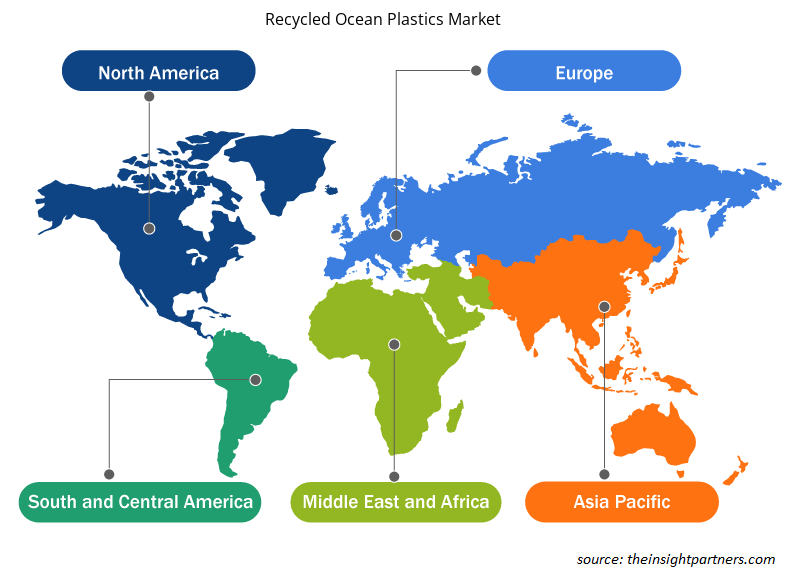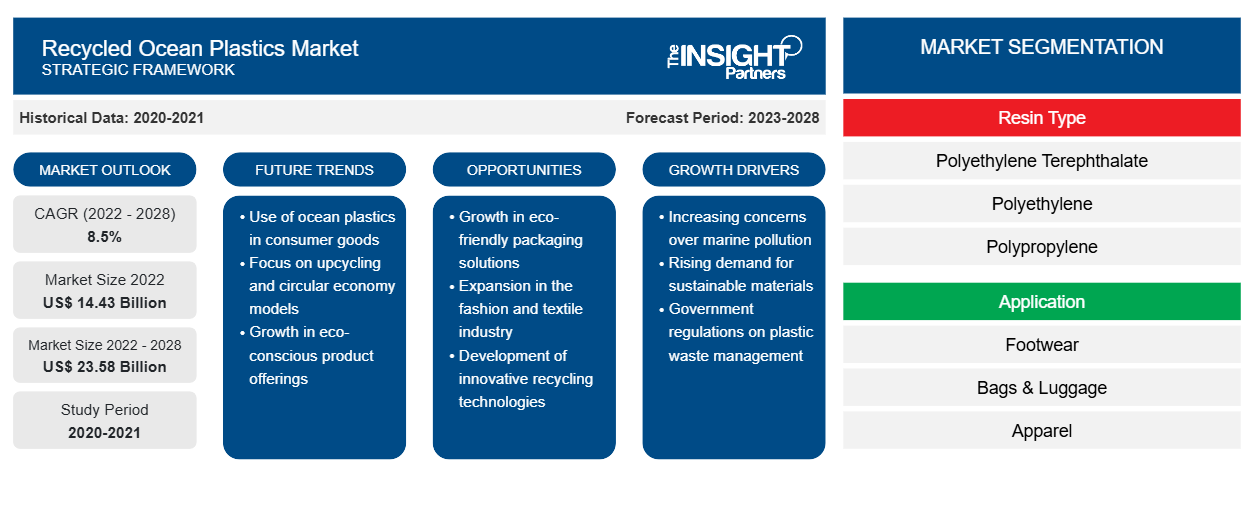2022년 재활용 해양 플라스틱 시장 규모는 14,432.91백만 달러로 평가되었으며, 2022년에서 2028년까지 연평균 성장률 8.5%로 성장할 것으로 예상됩니다.
플라스틱 오염은 생물에 미치는 부정적인 영향으로 인해 주요 우려 사항 중 하나입니다. 매년 수톤의 플라스틱 폐기물이 바다와 수로에 버려져 해양 생태계를 방해합니다. 따라서 제조업체는 바다 플라스틱 폐기물을 재활용하고 이러한 플라스틱으로 신발, 가방, 여행 가방, 지갑, 옷과 같은 유용한 제품을 생산하는 데 크게 집중하고 있습니다.
2021년 아시아 태평양 지역은 글로벌 재활용 해양 플라스틱 시장 에서 가장 큰 매출 점유율을 차지했습니다 . 아시아 태평양 시장은 인도, 중국, 호주, 일본, 한국 및 기타 아시아 태평양 지역으로 세분화됩니다. 이 지역의 재활용 해양 플라스틱 시장 성장은 빠르게 확장되는 패션 산업, 인구 증가, 지역 전체의 지속 가능한 솔루션에 대한 소비자 인식 증가에 의해 주도됩니다. 중국과 인도는 인구가 가장 빠르게 증가하는 국가 중 하나입니다. 인구 증가로 인해 이 지역에서 신발, 포장 및 건설 산업이 빠르게 발전하고 있습니다. 친환경 제품을 생산하여 탄소 발자국을 줄이려는 지역 제조업체의 이니셔티브가 확대됨에 따라 이 지역의 재활용 해양 플라스틱 시장 성장도 촉진되고 있습니다.
귀하의 요구 사항에 맞게 이 보고서를 사용자 정의하세요
이 보고서의 일부 또는 국가 수준 분석, Excel 데이터 팩을 포함하여 모든 보고서에 대한 사용자 정의를 무료로 받을 수 있으며 신생 기업 및 대학을 위한 훌륭한 혜택과 할인 혜택을 이용할 수 있습니다.
- 이 보고서의 주요 시장 동향을 알아보세요.이 무료 샘플에는 시장 동향부터 추정 및 예측까지 다양한 데이터 분석이 포함됩니다.
COVID-19 팬데믹이 재활용 해양 플라스틱 시장에 미치는 영향
신발, 의류, 포장 및 건설 산업에서 지속 가능하고 환경 친화적인 소재에 대한 요구가 증가함에 따라 COVID-19 팬데믹 위기가 시작되기 전에 재활용 해양 플라스틱에 대한 수요가 증가했습니다. 그러나 2020년에 다양한 국가 정부가 SARS-CoV-2 감염 확산을 통제하기 위해 봉쇄 조치를 시행하여 플라스틱 재활용 단위의 운영이 중단되어 재활용 해양 플라스틱이 부족해졌습니다. GA Circular에서 발표한 보고서에 따르면 인도, 베트남 및 필리핀의 재활용 단위의 80%가 2020년 초에 문을 닫았고 이로 인해 재활용 플라스틱이 상당히 부족 했습니다. 이는 재활용 해양 플라스틱 시장 성장에 부정적인 영향을 미쳤습니다.
2021년에 많은 경제권이 운영을 재개했습니다. 다양한 국가의 정부는 이전에 부과된 제한을 완화하고 제조업체가 최대 용량으로 운영할 수 있도록 허용했습니다. 이 요인은 플라스틱 재활용 활동에 긍정적인 영향을 미쳤습니다. 많은 정부와 NGO가 순환 경제를 지원하고 해양 생태계에 대한 플라스틱 폐기물의 위협을 최소화하기 위해 견고한 폐기물 관리 인프라를 구축하고 있습니다. 이 요인은 예측 기간 동안 재활용된 해양 플라스틱에 대한 수요를 촉진할 것입니다.
시장 통찰력
재활용 해양 플라스틱으로 만든 제품 출시 증가
플라스틱 오염은 생물체에 심각한 위협을 가하기 때문에 시급한 글로벌 과제입니다. 유엔 교육 과학 문화 기구의 Ocean Literacy Portal에서 제공한 통계에 따르면 플라스틱 폐기물은 전체 해양 오염의 약 80%를 차지하고 매년 약 800만~1,000만 톤(MMT)의 플라스틱이 바다로 유입됩니다. 게다가 바다의 미세 플라스틱 양은 앞으로 크게 증가할 것으로 예상됩니다. 그럼에도 불구하고 많은 국가에서 바다의 플라스틱 오염에 대한 인식이 높아졌고 정부와 규제 기관은 이러한 플라스틱을 재활용하기 위한 이니셔티브를 취하고 있습니다. 많은 회사가 재활용된 바다 플라스틱을 사용하여 신발, 핸드백 및 지갑, 선글라스, 의류와 같은 혁신적이고 매력적인 제품을 출시하여 지속 가능성 목표를 달성하고 전반적인 환경 발자국을 줄이고 있습니다. 언급된 모든 요소가 재활용된 바다 플라스틱 시장 성장을 촉진합니다.
수지 유형 통찰력
수지 유형에 따라 글로벌 재활용 해양 플라스틱 시장은 폴리에틸렌 테레프탈레이트(PET) , 폴리에틸렌(PE), 폴리프로필렌(PP), 폴리스티렌(PS) 등으로 세분화됩니다. 폴리에틸렌 테레프탈레이트 세그먼트는 2021년 시장에서 가장 큰 점유율을 차지했습니다. 폴리에틸렌 테레프탈레이트(PET)는 무게가 더 무겁고 모양을 유지하는 능력으로 인해 바다와 수로에서 쉽게 추출할 수 있어 세그먼트의 시장 성장을 뒷받침합니다. 게다가 가방 및 여행 가방, 신발용 재활용 해양 PET에 대한 수요가 증가하면서 이 지역의 시장 성장도 촉진되고 있습니다.
애플리케이션 인사이트
응용 프로그램을 기준으로, 글로벌 재활용 해양 플라스틱 시장은 신발, 가방 및 여행 가방, 의류, 건축 자재 및 기타로 세분화됩니다. 의류 부문은 2021년에 가장 큰 시장 점유율을 차지했습니다. 패션 산업의 의류 수요 증가와 증가하는 세계 인구는 향후 몇 년 동안 섬유 산업에서 재활용 해양 플라스틱에 대한 수요를 촉진할 것으로 예상됩니다.
Aquafil SpA, BIONIC, Tide Ocean SA, Oceanworks, Textil Santanderina, Envision Plastics, OceanYarn, Waste2Wear, Unifi, Inc., SABIC은 재활용 해양 플라스틱 시장에서 활동하는 업체 중 일부입니다. 이러한 회사는 새로운 소비자 요구 사항을 해결하기 위해 혁신적인 제품을 개발하기 위해 R&D에 상당한 투자를 하고 있습니다. 시장 참여자는 고객 수요를 충족하기 위해 고품질 제품을 제공하는 데 중점을 둡니다.
재활용 해양 플라스틱 시장 지역 통찰력
Insight Partners의 분석가들은 예측 기간 동안 재활용 해양 플라스틱 시장에 영향을 미치는 지역적 추세와 요인을 철저히 설명했습니다. 이 섹션에서는 북미, 유럽, 아시아 태평양, 중동 및 아프리카, 남미 및 중미의 재활용 해양 플라스틱 시장 세그먼트와 지리에 대해서도 설명합니다.

- 재활용 해양 플라스틱 시장에 대한 지역별 특정 데이터 얻기
재활용 해양 플라스틱 시장 보고서 범위
| 보고서 속성 | 세부 |
|---|---|
| 2022년 시장 규모 | 144억 3천만 달러 |
| 2028년까지 시장 규모 | 235억 8천만 달러 |
| 글로벌 CAGR (2022-2028) | 8.5% |
| 역사적 데이터 | 2020-2021 |
| 예측 기간 | 2023-2028 |
| 다루는 세그먼트 | 수지 유형별
|
| 포함된 지역 및 국가 | 북아메리카
|
| 시장 선도 기업 및 주요 회사 프로필 |
|
재활용 해양 플라스틱 시장 참여자 밀도: 비즈니스 역학에 미치는 영향 이해
재활용 해양 플라스틱 시장 시장은 소비자 선호도의 변화, 기술 발전, 제품의 이점에 대한 인식 증가와 같은 요인으로 인해 최종 사용자 수요가 증가함에 따라 빠르게 성장하고 있습니다. 수요가 증가함에 따라 기업은 제품을 확장하고, 소비자의 요구를 충족하기 위해 혁신하고, 새로운 트렌드를 활용하여 시장 성장을 더욱 촉진하고 있습니다.
시장 참여자 밀도는 특정 시장이나 산업 내에서 운영되는 회사나 기업의 분포를 말합니다. 주어진 시장 공간에 얼마나 많은 경쟁자(시장 참여자)가 존재하는지 그 규모나 전체 시장 가치에 비해 나타냅니다.
재활용 해양 플라스틱 시장에서 활동하는 주요 기업은 다음과 같습니다.
- 아쿠아필스페
- 바이오닉
- 타이드 오션 SA
- 오션웍스
- 텍스틸 산탄데리나
면책 조항 : 위에 나열된 회사는 어떤 특별한 순서에 따라 순위가 매겨지지 않았습니다.

- 재활용 해양 플라스틱 시장의 주요 주요 업체 개요를 알아보세요
스포트라이트 보고서
- 재활용 해양 플라스틱 시장의 진보적인 산업 동향은 플레이어가 효과적인 장기 전략을 개발하는 데 도움이 됩니다.
- 선진국과 개발도상국 시장에서 채택한 사업 성장 전략
- 2020년부터 2028년까지 재활용 해양 플라스틱 시장에 대한 정량적 분석
- 재활용된 해양 플라스틱에 대한 세계적 수요 추산
- 산업에서 운영되는 구매자와 공급자의 효율성을 설명하기 위한 포터의 5가지 힘 분석
- 경쟁 시장 시나리오를 이해하기 위한 최근 개발
- 재활용 해양 플라스틱 시장 성장을 주도하고 제한하는 요인과 더불어 시장 동향 및 전망
- 상업적 관심을 뒷받침하는 시장 전략을 강조하여 의사 결정 과정을 지원하고 재활용 해양 플라스틱 시장 성장을 이끕니다.
- 다양한 노드에서의 재활용 해양 플라스틱 시장 규모
- 시장의 자세한 개요 및 세분화, 재활용 해양 플라스틱 산업 역학
- 성장 기회가 유망한 다양한 지역의 재활용 해양 플라스틱 시장 규모
글로벌 재활용 해양 플라스틱 시장
글로벌 재활용 해양 플라스틱 시장은 수지 유형별로 폴리에틸렌 테레프탈레이트(PET), 폴리에틸렌(PE), 폴리프로필렌(PP), 폴리스티렌(PS) 등으로 세분화됩니다. 응용 분야별로 시장은 신발, 가방 및 수하물, 의류, 건축 자재 등으로 세분화됩니다.
회사 프로필
- 아쿠아필스페
- 바이오닉
- 타이드 오션 SA
- 오션웍스
- 텍스틸 산탄데리나
- 엔비전 플라스틱스
- 오션얀
- 웨이스트투웨어
- 유니파이 주식회사
- 사빅 아몬
- 과거 분석(2년), 기준 연도, CAGR을 포함한 예측(7년)
- PEST 및 SWOT 분석
- 시장 규모 가치/거래량 - 글로벌, 지역, 국가
- 산업 및 경쟁 환경
- Excel 데이터세트
최근 보고서
관련 보고서
사용 후기
구매 이유
- 정보에 기반한 의사 결정
- 시장 역학 이해
- 경쟁 분석
- 고객 인사이트
- 시장 예측
- 위험 완화
- 전략 기획
- 투자 타당성 분석
- 신흥 시장 파악
- 마케팅 전략 강화
- 운영 효율성 향상
- 규제 동향에 발맞춰 대응





















 무료 샘플 받기 - 재활용 해양 플라스틱 시장
무료 샘플 받기 - 재활용 해양 플라스틱 시장